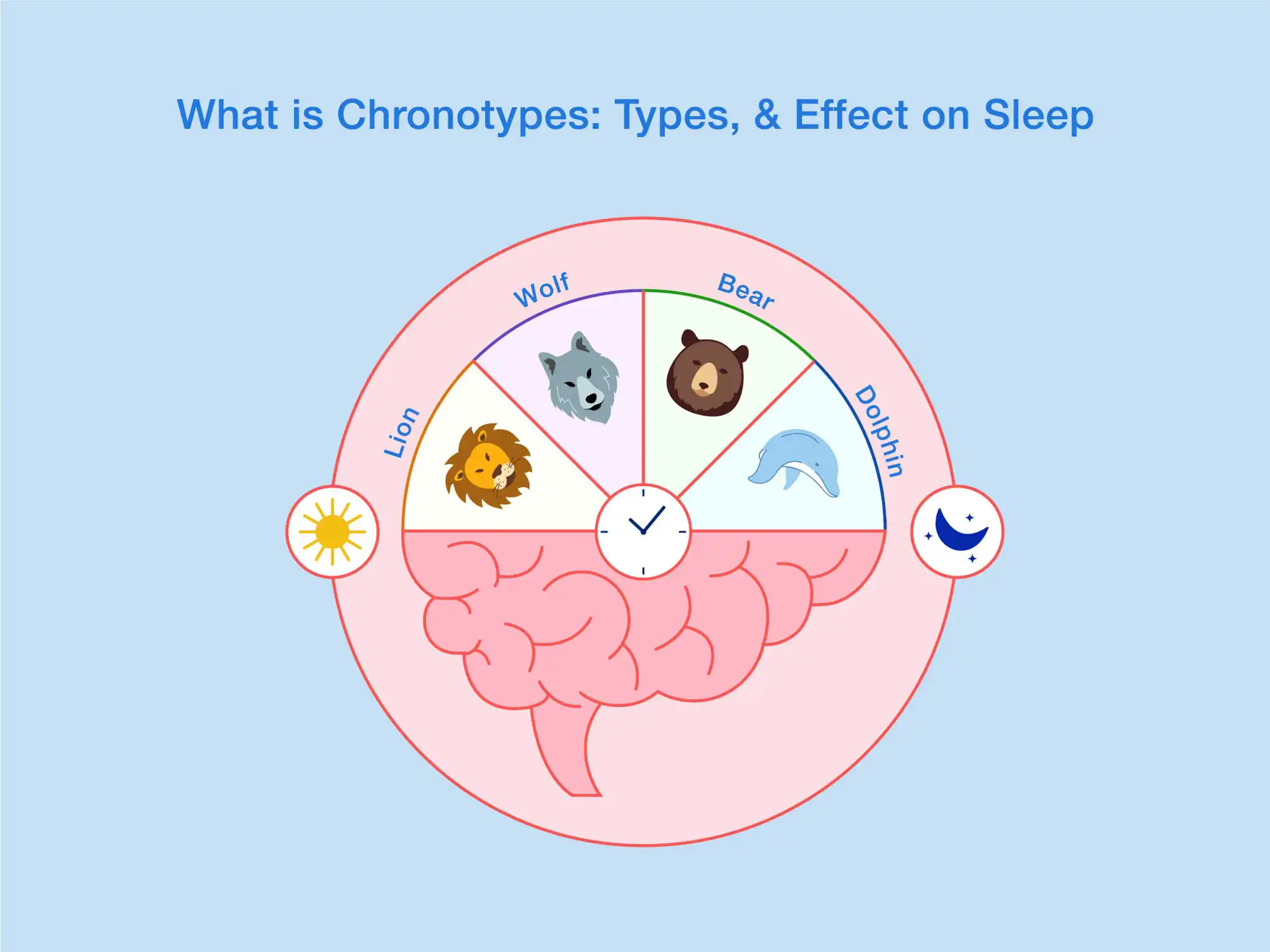Sleep Health
Published March 3, 2023
8 minWhat Is Chronotype Types, & Effect On Sleep
Are you a night owl who enjoys staying awake until late at night? Or maybe you enjoy rising early. This is because we identify with a certain chronotype. But, what is chronotype? How is it associated

Table of contents
What Is a Chronotype? How Do Chronotypes Work? Types of Chronotypes How Do You Tell Your Chronotype? Benefits of Knowing Your Chronotype Using Your Chronotype to Get Better Sleep Frequently Asked Questions
Are you a night owl who enjoys staying awake until late at night? Or maybe you enjoy rising early. This is because we identify with a certain chronotype. But, what is chronotype? How is it associated with sleep? Does knowing your chronotype help? Yes, chronotype gives you an insight into your body’s internal clock. So, let’s unpack more. Keep reading to know more! You are the lion chronotype if you are a morning person who feels your best when you wake up early. People with this chronotype feel productive and energetic in the mornings and can finish a major chunk of their work before lunch.But post lunch, they enter a slump and need a power nap to recharge themselves. The lion chronotype also hits the sheets early and sleeps around 10 pm every night. They usually require at least 8 hours of sleep every night. Almost 15% of the population are lions. They are the ones you see exercising early and are usually first to the office too!
You are the lion chronotype if you are a morning person who feels your best when you wake up early. People with this chronotype feel productive and energetic in the mornings and can finish a major chunk of their work before lunch.But post lunch, they enter a slump and need a power nap to recharge themselves. The lion chronotype also hits the sheets early and sleeps around 10 pm every night. They usually require at least 8 hours of sleep every night. Almost 15% of the population are lions. They are the ones you see exercising early and are usually first to the office too!  Almost 55% of the population are bear. They have no trouble falling asleep or waking up on time and can enjoy a peaceful rest throughout the night. Their productivity levels are high in the morning. But like the lions, they hit a slump post lunch around 2-4 pm. They usually need 7-8 hours of sleep between 11 pm to 7 am.
Almost 55% of the population are bear. They have no trouble falling asleep or waking up on time and can enjoy a peaceful rest throughout the night. Their productivity levels are high in the morning. But like the lions, they hit a slump post lunch around 2-4 pm. They usually need 7-8 hours of sleep between 11 pm to 7 am.  15% of the world’s population is a wolf and is most productive once the sun sets. They usually have trouble waking up and going to sleep early. Wolfs showcase two creativity bursts, one around noon and the other after 6 pm. They are considered to the night owl!
15% of the world’s population is a wolf and is most productive once the sun sets. They usually have trouble waking up and going to sleep early. Wolfs showcase two creativity bursts, one around noon and the other after 6 pm. They are considered to the night owl!  The rarest chronotype is the dolphin and only 10% of the world’s population is one. They portray anxious sleep behaviors where they experience trouble falling asleep and cannot enjoy a peaceful rest throughout the night. Dolphins can always opt for a power nap to enhance their productivity levels when they feel dull and fatigued. Due to their erratic sleep patterns, they don’t relish good quality sleep.
The rarest chronotype is the dolphin and only 10% of the world’s population is one. They portray anxious sleep behaviors where they experience trouble falling asleep and cannot enjoy a peaceful rest throughout the night. Dolphins can always opt for a power nap to enhance their productivity levels when they feel dull and fatigued. Due to their erratic sleep patterns, they don’t relish good quality sleep.
What Is a Chronotype?
Simply put, sleep chronotype is your inclination towards sleep, wake, and alertness during the day and night. When you understand your chronotype, you can understand your internal clock better. So, it helps you plan your activities and duties better.Circadian Rhythms vs. Chronotypes
Circadian rhythm is the body’s internal clock running 24/7 in the background and is responsible for your sleep-wake cycle. It is influenced by light and darkness and other environmental cues. When your internal clock is properly aligned, it helps you enjoy a peaceful deep shuteye effortlessly. Whereas chronotype is a type of circadian rhythmicity. Your circadian rhythm can be trained when you maintain a strict schedule but your underlying chronotype cannot be changed. For instance, if you are a night owl and have to be at work at 8 AM every day, you may wake up at 7. But you only tend to feel productive later in the day. However, chronotype doesn’t affect your total sleep time but influences your productivity and sleep-wake time. Social jetlag is when your chronotype interferes with your day-to-day schedules, such as work or school. Hence, it can make you feel exhausted.How Do Chronotypes Work?
Your chronotypes come from the PER3 gene and rely on age, environmental, and genetic factors. While we cannot actively work towards changing our chronotype, it usually shifts as we grow older. Here, circadian rhythm and chronotype work together. For instance, our circadian rhythm starts melatonin production at night and halts it in the morning. But your chronotype can influence the production of melatonin. So, let’s say you are a night owl. Chances are that your melatonin production may be delayed.Types of Chronotypes
Wondering what is my chronotype? Let’s understand the four types in the chronotype chart and learn more.Lion
 You are the lion chronotype if you are a morning person who feels your best when you wake up early. People with this chronotype feel productive and energetic in the mornings and can finish a major chunk of their work before lunch.But post lunch, they enter a slump and need a power nap to recharge themselves. The lion chronotype also hits the sheets early and sleeps around 10 pm every night. They usually require at least 8 hours of sleep every night. Almost 15% of the population are lions. They are the ones you see exercising early and are usually first to the office too!
You are the lion chronotype if you are a morning person who feels your best when you wake up early. People with this chronotype feel productive and energetic in the mornings and can finish a major chunk of their work before lunch.But post lunch, they enter a slump and need a power nap to recharge themselves. The lion chronotype also hits the sheets early and sleeps around 10 pm every night. They usually require at least 8 hours of sleep every night. Almost 15% of the population are lions. They are the ones you see exercising early and are usually first to the office too! Bear
 Almost 55% of the population are bear. They have no trouble falling asleep or waking up on time and can enjoy a peaceful rest throughout the night. Their productivity levels are high in the morning. But like the lions, they hit a slump post lunch around 2-4 pm. They usually need 7-8 hours of sleep between 11 pm to 7 am.
Almost 55% of the population are bear. They have no trouble falling asleep or waking up on time and can enjoy a peaceful rest throughout the night. Their productivity levels are high in the morning. But like the lions, they hit a slump post lunch around 2-4 pm. They usually need 7-8 hours of sleep between 11 pm to 7 am. Wolf
 15% of the world’s population is a wolf and is most productive once the sun sets. They usually have trouble waking up and going to sleep early. Wolfs showcase two creativity bursts, one around noon and the other after 6 pm. They are considered to the night owl!
15% of the world’s population is a wolf and is most productive once the sun sets. They usually have trouble waking up and going to sleep early. Wolfs showcase two creativity bursts, one around noon and the other after 6 pm. They are considered to the night owl! Dolphin
 The rarest chronotype is the dolphin and only 10% of the world’s population is one. They portray anxious sleep behaviors where they experience trouble falling asleep and cannot enjoy a peaceful rest throughout the night. Dolphins can always opt for a power nap to enhance their productivity levels when they feel dull and fatigued. Due to their erratic sleep patterns, they don’t relish good quality sleep.
The rarest chronotype is the dolphin and only 10% of the world’s population is one. They portray anxious sleep behaviors where they experience trouble falling asleep and cannot enjoy a peaceful rest throughout the night. Dolphins can always opt for a power nap to enhance their productivity levels when they feel dull and fatigued. Due to their erratic sleep patterns, they don’t relish good quality sleep.











